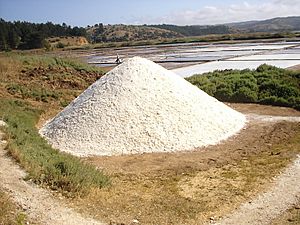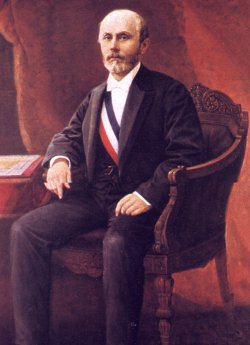History of Pichilemu facts for kids

The history of Pichilemu began a long time ago, around the 1500s. At that time, a group of people called the Promaucaes lived in the area where Pichilemu is today. A Chilean historian named José Toribio Medina wrote in his book Los Restos Indígenas de Pichilemu (1908) that a Spanish conqueror, Pedro de Valdivia, gave some land called Topocalma to Juan Gómez de Almagro on January 24, 1544. Pichilemu was part of this land.
The name Pichilemu comes from the Mapudungún language. Pichi means "little," and lemu means "forest." So, Pichilemu means "little forest." A large farm, or hacienda, called Petrel (also known as San Antonio de Petrel) was located about 18 kilometers east of Pichilemu. This is where José María Caro Rodríguez, who became a very important religious leader, was born.
The Ortúzar Cuevas family, who owned the Petrel hacienda, built a dock in 1887. This dock was later burned during the 1891 Chilean Civil War. It was rebuilt but then destroyed again in 1911. The family also built the first neighborhood in what is now called Daniel Ortúzar Avenue. The city of Pichilemu was officially created on December 22, 1891, by a special order from President Jorge Montt.
Agustín Ross, a Chilean writer and politician, built many important places in Pichilemu. These include the Agustín Ross Hotel, a casino (now the Agustín Ross Cultural Centre), the Agustín Ross Balcony, and the Agustín Ross Park. A railway line connecting San Fernando to Pichilemu was built over 57 years, from 1869 to 1926. The Pichilemu railway station opened in 1926.
The Cardenal Caro Province was created on September 24, 1979, by President Augusto Pinochet. It was named to honor José María Caro Rodríguez, the first Chilean Catholic Cardinal. Pichilemu is the main city, or capital, of this province.
Early History of Pichilemu
The Promaucaes were the first people to live in the Pichilemu area. They were hunter-gatherers and fishermen. They mostly lived along the Cachapoal and Maule rivers. The Promaucaes also collected salt from the Cáhuil salt flats.
On January 24, 1544, the Spanish conqueror Pedro de Valdivia gave Juan Gómez de Almagro a large piece of land called the Topocalma encomienda. This land included the area where Pichilemu is now. This information comes from the Chilean historian José Toribio Medina in his book Los Restos Indígenas de Pichilemu.
The native people that the Spaniards found in that place [Pichilemu] were definitely Promaucaes. They must have been part of the Topocalma encomienda, which Pedro de Valdivia gave to Juan Gómez de Almagro on January 24, 1544. Both facts are clear from the document about that encomienda: "I give to you Juan Gómez," said Valdivia, "the Palloquierbico, Topocalma, and Gualauquén chiefs, along with their families and native people, who are living in the Promaucaes provinces, near the sea coast."
—José Toribio Medina, Imprenta Cervantes, 1908.
In the late 1500s, Spanish monks started planting vineyards in Pichilemu. In 1607, the Spanish Governor Alonso García Ramón gave Captain Tomás Duran land near Petrel Lagoon, where Pichilemu is located today.
In 1611, Bartolomé de Rojas y Puebla received land near Topocalma from the Spanish government. He bought more land to create the Hacienda San Antonio de Petrel. This farm brought good money to Rojas y Puebla and the owners after him. They made leather, dried meat, and other products. They also rented out land for grazing animals. Products from Petrel were sent to Peru and sold in Santiago and Valparaíso. Petrel also suffered a lot during dry periods in 1730, 1740, and 1780.
In the early 1600s, a count of people in Colchagua showed that Cáhuil, an important area near Pichilemu, had 1,678 people.
In 1778, a church was built in Ciruelos and became a small church. Years later, in 1864, it became a full parish. By 1787, Pichilemu had 1,688 people.
In the late 1860s, work began on a railway line from San Fernando to Pichilemu. It was finished in 1926.
In 1872, the President of Chile Aníbal Pinto asked a navy captain named Francisco Vidal Gormaz to study the coast. Vidal found that places like Matanzas and Cáhuil were too open for ships. He thought Tumán, Topocalma, and Pichilemu were better. He decided that Pichilemu was the best place to build a port for ships.
San Antonio de Petrel, owned by the Ortúzar family, was first called "Pichilemu" in 1873. It was described as a small village. The Ortúzar family built a dock in 1875, which was used for fishing. The Pedro Pavez Polanco and Ortúzar Cuevas families owned a lot of land. They built historic homes and buildings, like the Pichilemu post office building, over the years.
In 1885, Agustín Ross, a Chilean writer and politician, bought a large piece of land (about 300 hectares). He named it La Posada, which means "The Inn." At first, it was just some simple buildings. That year, Ross built the Ross Park and the Great Hotel Pichilemu. The Great Hotel Pichilemu, now called Ross Hotel, is one of the oldest hotels in Chile.
When he arrived here, there was nothing. Maybe just a couple of houses. He started to shape the town, giving it a European feel. Look at the railings that decorate the seafront or those around the park; they are the same ones Mr. Agustín saw in Biarritz. Cuando él llegó, acá no había nada. Un par de casas, cuando mucho. Él fue dando forma al pueblo, él le dio aires europeos. Mire esas balaustradas que adornan la costanera o las que bordean el parque, son las mismas que don Agustín vio en Biarritz.
—Jaime Parra, El Mercurio, January 22, 2000.
In 1887, President José Manuel Balmaceda declared Pichilemu a small dock. In March 1887, the first merchant ship arrived. Years later, during the 1891 Chilean Civil War, the dock was burned by troops. It was rebuilt and used until 1912, but it never became a major port.
Founding the Municipality
The families of Lauriano Gaete and Ninfa Vargas, with the help of engineer Emilio Nichón, planned the village of Pichilemu. They soon began building according to this new plan and the existing Ortúzar neighborhood.
After the 1891 Civil War, the new President Jorge Montt created many new towns, or "communes," including Pichilemu. This happened through a law called the "law of the autonomous commune."
In 1894, the Municipality of Pichilemu was created. It included the areas of what are now Pumanque and Marchihue. Local citizens met to choose their first Mayors and council members. José María Caro Martínez was chosen as the first Mayor of Pichilemu. He officially approved the city plan in 1894.
Caro Martínez was elected Mayor four times in a row: from 1894 to 1897, 1897 to 1900, 1900 to 1903, and 1903 to 1906. However, he left office in 1905. The Second Mayor, Francisco Javier Asalgado, took over and stayed in office until 1909.
In 1905, Agustín Ross built a special building. It had the first mail and telegraph service in Pichilemu and a large store. This building had three floors and was made with materials brought from other countries. It opened as the first casino in Chile on January 20, 1906.
In 1908, Agustín Ross and Evaristo Merino told historian José Toribio Medina about old native remains found in a cave in Pichilemu. Medina asked an Argentinian expert, Félix Faustino Outes, to look at the remains. Medina then wrote the book "Los Restos Indígenas de Pichilemu" with Outes' full report. Earlier that year, on January 16, Pichilemu's first newspaper, El Puerto, was started by Augusto Ramírez. It didn't last long, but on January 14, 1917, Ramírez began publishing another newspaper called El Marino. Only 33 issues of El Marino were printed.
In March 1909, new local elections were held, but there were some problems with counting the votes. In September, a court decided that Carlos Salas Salas was the new Mayor of Pichilemu. Francisco Javier Asalgado became Mayor after him in 1912, but he resigned in June of that year. José Santos Becerra then took over.





